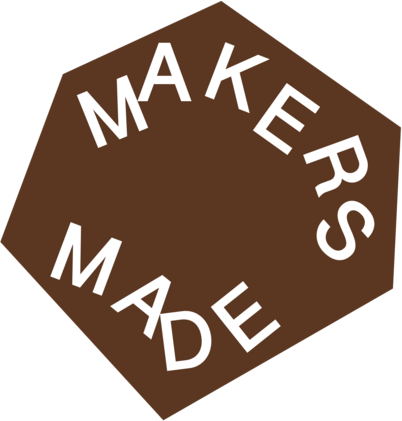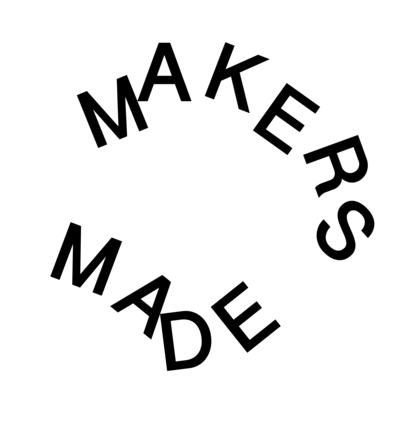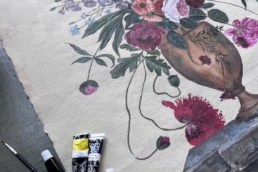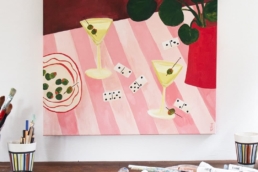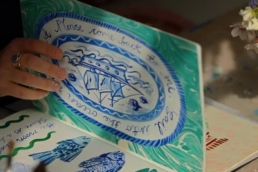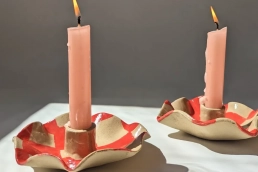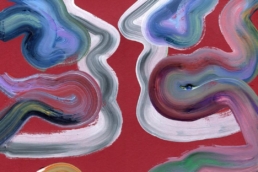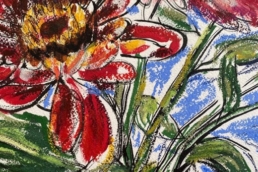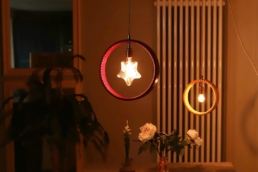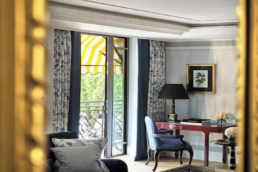In this Q&A, we speak with artist Ruby Bateman about her lifelong artistic journey—from childhood creativity at the kitchen table to studying at the Royal College London, and now working from her cosy studio in Devon. Ruby shares insights into her intuitive creative process, the emotional narratives woven through her paintings, and how ancient histories, myths, and folk culture deeply inspire her work. She discusses the joy of collaboration and the importance of authenticity in the artistic journey

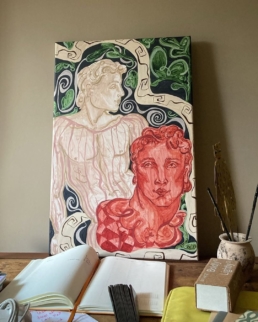
1. Can you tell us a bit about yourself and your artistic journey?
My artistic journey started at the kitchen table around age four; making mechanical dolphins out of card and computers out of cereal boxes, eventually leading me to study a print at Brighton, and then a Masters at the Royal College London. Now you can find me at my home studio in Devon, painting and drawing which I love best.
2. What inspired you to pursue your craft? Was there a defining moment or influence that sparked your passion?
It has always been an intuition of mine, something that has not felt like a choice. I remember saying aged five that I wanted to be an artist and a mummy, and I still stand by that.
Your craft
3. How would you describe your work in three words?
Swirly. heartfelt. old-worldy
4. What materials or techniques do you use, and why are they important to your process?
I’d ideally like to paint in oil, but I’m so sensitive to smells I can’t stand it! To compromise I’ve tried to make my acrylic paintings as ‘liquid’ and gestural as possible. It’s dryness does appeal to my impatient side, and I do quite like how immediate it is to use.
Every single work starts out with a pencil drawing, so that has always been at the heart of my process, whether it be an indian ink drawing on cartridge paper or acrylic painting on cotton canvas.
5. Can you tell us about a favourite piece you’ve created and the story behind it?
A favourite work of mine is ‘Many Have Walked But Not in Your Shoes’ acrylic on canvas triptych. This large two piece was the show stopper at my solo exhibition ‘PASSAGE’ at Haricot Gallery in 2023. It’s about pilgrimage; the transformational act of walking and paying reverence to a place. As Satish Kumar suggests, if we walk more like pilgrims on this Earth rather than tourists (self-serving and looking to find things to consume), we might have a richer, healthier planet and inner self. This painting marks the places I hope to visit around the UK, my birthplace and heritage, which I hope to pilgrimage to one day.

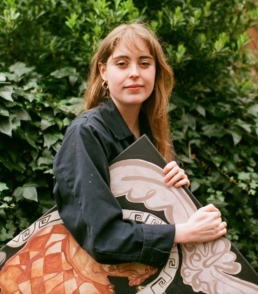

Creative process
6. What does a typical day in your studio or workshop look like?
My art making is cosy and domestic, with frequent trips to the kitchen for tea and snacks! I will wake up and get straight to work in my home studio, and will enjoy a 9-5 working day, suiting my morning personality. I will always be listening to something, Radio 4, podcasts, music. It’s wide ranging to hold me through a variety of moods and more often than not challenging scenarios in the studio.
7. Do you have any unique rituals or habits that help you stay creative?
I have a very large pinterest board which I save all my drawings references to. I love to draw from classical statues, old masters paintings and turn of the century black and white photographs.
A stick of palo santo or copal will usually be burning which grounds and inspires me, with continuous tea throughout the day.
8. How do you handle creative blocks? Do you have any strategies or tips for overcoming them?
I will always just try to make something. Perseverance and showing up for the work is integral, even if I don’t feel like making. I still haven’t figured out the secret to making a piece of work I like, it can suddenly come about when I am exhausted and stressed after trying for ages and not being in the mood. Or it can come when I am relaxed, ready and in flow. It’s this cosmic comedy I live with, so I just have to show up and see what happens!
Challenges and successes
9. What’s the biggest challenge you’ve faced as a maker, and how did you overcome it?
Expectation and reality are always a challenge for me. The painting I expect will come out, verses the painting which actually emerges. I essentially don’t have the control I think I do which creates tension. Ink drawing for me is easier, it is like playing an instrument, but painting is the true challenge, it is like conducting an orchestra. There is so much to balance and lose control of. I always chuckle to myself when I go to create a series of work in the same colour scheme, as I find it impossible to mix the same colour twice, so each work will insist on coming out exactly as it is regardless of the effort I put it to manipulate it elsewhere. It is a process of acceptance, which I might always be working through.
10. What’s been your proudest moment or achievement so far?
All my solo shows have been a gift to me, a validation that my work matters to someone. You spend all your days alone, creating, in this echo chamber of yourself, unable to actually see the work for what it is. When a gallery come along and chooses YOUR things, it is the greatest catharsis. It says that people are ready and interested in what you’ve been doing and your particular perspective and expression. The job that you do that bewilders most people actually exists for a moment in the ‘real world’.

Inspiration
11. Where do you draw inspiration from for your work? What sparks your imagination and creativity?
I’ve always loved old worlds, ancient Rome/Greece, the Medieval, Georgian and Victorian England, myths, folklore and legends. I’m hardwired to live in these places, so my creativity naturally springs from there. Some shout outs to William Blake, Weird Walk magazine, Dr Martin Shaw, the Bloomsbury Group Artists, The Bible of British Taste, Julia Maragret Cameron, Luke Edward Hall and Faye Weiwei.
Engaging with nature, old landmarks, ancient stones, cathedrals, moorlands, churches, castles, National Trust homes, walkways, bridlepaths, ancient (rainforests) woodland, ceremonies, rituals, plant magic and old stories connect me to a deeper creative consciousness and open heartedness.
12. Do you have a favourite artist, maker, movement, or tradition that has influenced your craft?
Around age 17 I discovered Frida Kahlo, who imprinted narrative, introspection and the soulfulness of being a woman (artist) onto me. I felt very close to her and still do. I managed to visit her homes in Mexico last summer in 2024, which was a wonderful pilgrimage for my old artist self. Shortly after came William Blake, another soul shaker, who’s ecstatic relationship to art making and his own uniqueness was deeply magical.
13. How does colour influence your practice; is it an important part of your process? Do you have a particular palette or favourites? Any go-to sources for colour inspiration?
Red is my spirit colour, so I will generally stick to that tonality. I love looking at Charleston House Bloomsbury Group artists for colour inspiration and William Blake’s coloured prints. I will tend to mix brown into most my colours as I prefer a more muted range, something slightly more natural.
Perspectives and goals
14. What role does your environment play in shaping your creativity?
Where I live in Devon, we are experiencing a rich revival of folk culture which has been highly influential in my work. Local writers, makers, galleries and musicians are connecting to our old heritage and stories. In recent works I’ve been creating drawings based off retellings of myths and folktales from local writers, I’ve loved connecting to their work in this way.
15. What do you want people to feel when they experience your work?
To experience beauty and rest within my some of my images, and in others ask questions around our connection to this world, where do we come from, what is our true nature and how can we create a more peaceful intuitive life (together).
16. What are you currently working on, and what excites you most about it?
As mentioned previously, I’m making work based off local writer’s myths and legends, but also interested in origin stories. The stories we tell ourselves, the stories that live in our bodies and the stories we have inherited through generational trauma. How do we honour these and transform them.
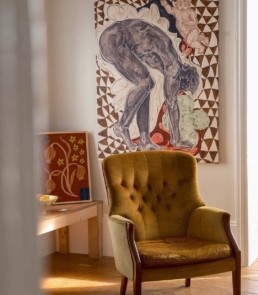
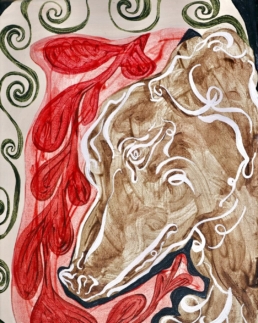
Advice and reflection
17. What advice would you give to someone starting out as a maker?
The work always should come first. Instead of worrying about which gallery to exhibit in or how to exhibit your work, make the work steadily and be an artist. All the rest will follow in due course.
18. If you could go back to the start of your career, what advice would you give your younger self?
Connect to the way you started out with painting and drawing, not what you think is fashionable or what people want to see.

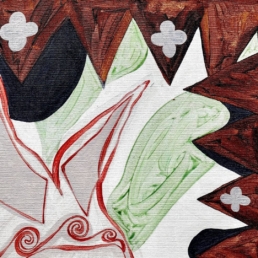

Closing thoughts
19. If you could collaborate with any artist, past or present, who would it be and why?
I’d love to collaborate with Kate Bush and do an installation of artwork and music together! I think her songwriting shows how much she reads, her brilliant enquiring mind and emotional depth. To make work in collaboration her stories and unique vision would be phenomenal!
20. Where can people find your work, and how can they support you?
Contacting me directly for commissions and sales is always a massive help! You can find me through Makers Made, my website rubybateman.com and giving me a follow on instagram @ruby__bateman
Ruby Bateman’s art beautifully blends introspection, mythology, and a rich sense of heritage, expressed through swirling lines, heartfelt narratives, and evocative colours. Her creations invite viewers to find both rest and reflection, connecting deeply with timeless themes and stories.
Explore Ruby’s latest collections and follow her creative journey:
Discover Ruby’s Work:
Support Ruby by reaching out directly for commissions, following her artistic adventures on Instagram, and engaging with her captivating creations through Makers Made.
